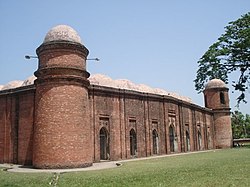| Bagerhat বাগেরহাট জেলা |
|
|---|---|
| District | |
| The historic Sixty Dome Mosque has become the symbol of Bagerhat District | |
| Location of Bagerhat in Bangladesh | |
| Coordinates: 22°40′00″N 89°48′00″ECoordinates: 22°40′00″N 89°48′00″E | |
| Country | |
| Division | Khulna Division |
| Capital | Bagerhat |
| Area | |
| • Total | 3,959.11 km2 (1,528.62 sq mi) |
| Elevation | 2 m (7 ft) |
| Population (1991) | |
| • Total | 1,515,815 |
| • Density | 380/km2 (990/sq mi) |
| Literacy rate | |
| • Total | 44.3% |
| Time zone | BST (UTC+6) |
| • Summer (DST) | BDST (UTC+7) |
| Postal code | 9000 |
| Website | dcbagerhat.gov.bd |
Contents
Geography
Bagerhat district has a total area of 3959.11 square kilometres. It is bounded by Gopalganj District and Narail District on the north, The Bay of Bengal on the south, Gopalganj District, Pirojpur District and Barguna District on the east and Khulna District on the west. Main rivers of the district are Panguchi, Daratana, Madhumati River, Pasur River, Haringhata, Mongla River, Baleswar, Bangra and Goshairkhali.History
Bagerghat, under the Khalifabad Pargana, is said to have been founded by Khan Jahan Ali, the ruler of Pargana from 1429-59. The Pargana region also included settlements like Khulna, Satkhira, Jessore and Barisal. After Khan Jahan Ali, the region was taken over by Maharaja Pratapaditya in 1459.[1] Located at the confluence of two historical rivers, the Brahmaputra River and the Ganges, Bagerghat is also known as the Mosque City for the presence of a large number of mosques in the district. The domed structures of the mosques built with bricks in the 15th century is considered an architectural marvel.[2]Khan Jahan Ali’s tomb is one of the main attractions of Bagerhat. The Shat(sixty) Gambuj Mosque built in 1459, considered a most unique structure in the whole of the Asian sub-continent, has been declared a World Heritage Site. The other places of historical importance in Bagerghat include Pocha Dighi & Ghora Dighi ponds.[1] Bagerghat was declared a district only in 1984.[3] Places of interest also include: Sundarban (world largest mangrove forest) and Port of Mongla, to name a few.[1] The district today is the fourth largest city in Bangladesh.
Economy
One of the two ports of Bangaldesh,Mangla, is here. Rampal and Fakirhat, two upazilla of Bagerhat is known as Qwait of Bangladesh due to its huge production of shrimp and earning a lot of foreign exchange.(55%)| This section requires expansion. (January 2007) |
Subdivisions
Bagerhat is divided into 9 upazilas, 77 union parishads, 1031 villages, 687 mouzas, 3 municipalities, 27 wards and 56 mahallas. The upazilas are:Administration
Administrator of Zila Porishod: Sheikh Kamruzzaman (Tuku) [1]Deputy Commissioner (DC): Md. Akram Hossain [2]
Transport
Bagerhat is the terminus of a branch railway from Khulna on the broad gauge system of Bangladesh Railways. The best way to go to Bagerhat from Dhaka is to take a bus which takes seven to eight hours. By air you have to go to Jessore airport then take a bus to the city. The total is 370.91 km, waterways 205 km and railway 24 km. There are 5 railway stations.Media
Print media:- Prothom Alo (National)
- The Daily Kaler kantho (National)
- The Daily Jugantar (National)
- The Daily Janakantha (National)
- Daily Purbanchal (Local)
- Airtel, BTCL, Bangla Link, Teletalk, Grameen Phone etc.
Religion
The district of Bagerhat consists 7815 mosques, 238 temples, 17 churches and seven tombs. The Sixty Pillar Mosque or Shat Gambuj Masjid is famous mosque. Khan Jahan Ali's tomb is the famous tombs.Places of interest
|
|
- Dohajari Shib Bari, Fakirhat



